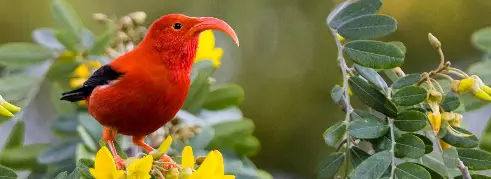Scientific Facts
| Common Name | ʻIʻiwi |
| Scientific Name | Drepanis coccinea |
| Lifespan | No data available |
| Size | 6 inches |
| Mass | 16 – 20 grams |
| Habitat | Mesic and wet forests |
| Origin | Hawaiian Islands |
Information & Physical Appearance
Scientifically referred to as Drepanis coccinea, the adult Iwii bird (originally transcribed as ʻIʻiwi), is mostly scarlet in color, and hence the common name scarlet honeycreeper.
The original scientific name for the Iwii bird used to be Vestiaria coccineca, and it is intricately related to the history of these amazing animals. Back in time, the Hawaiian nobility, locally known as aliʻi, used to highly prize the unique feathers of the scarlet honeycreeper, and they used them to decorate their traditional feathered helmets (mahiole), as well as the traditional feather cloaks (ʻahuʻula). “Vestaria” is a word of Latin origin and means “clothing,” while “coccinea” translates into “scarlet-colored.”
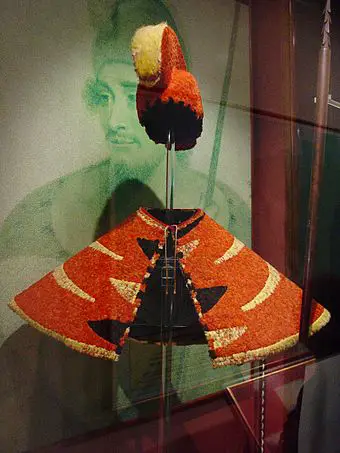
Mahiole and ʻAhuʻula, 200 years old –
It wasn’t before 2015 when the IOC World Bird List finally moved the Iwii bird to the genus Drepanis, with the word “Drepanis” being of Greek origin, and meaning “sickle,” which is used as a reference to the unusual shape of the scarlet honeycreeper’s beak.
The tail and wings of the scarlet honeycreeper are black in color. Meanwhile, the curved, long bill is salmon in color. In fact, it is thanks to the curiously-shaped bill of how these birds manage to drink nectar.
Because of the impressive, eye-catching contrast of the black and red plumage, it is effortless to spot the colorful Iwii birds among the green foliage in their natural habitat.
Compared with adults, young scarlet honeycreepers are “equipped” with golden foliage. Also, they have more spots, and their bills are ivory in color. Because of the differences in their physical appearance, younger Iwii birds are commonly mistaken for different bird species by newbie naturalists.
As young scarlet honeycreepers mature, they molt into the typical adult plumage.
Lifespan
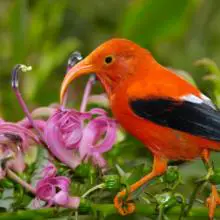
Up-to-date, there is still no data available regarding the lifespan of Iwii birds. What experts do know as of now, though, is that the maximum recorded lifespan of other Hawaiian honeycreepers is set at up to 12 years.
According to the IUCN Red List of Threatened Species, the generation length of iwiis is estimated at 4.9 years.
Ecosystem & Habitat
‘I‘iwi inhabit wet and mesic forests located at over 1500 elevation on the islands of Maui, Kaua‘i, and Hawaii.
The largest number of scarlet honeycreepers is known to occur in Hawaii, estimated at 362 000 birds in number. However, the Iwii populations on the lower-elevation islands of Moloka‘i and O‘ahu have significantly decreased, and nowadays, they consist of less than a total of 50 birds. These living creatures have gone fully extinct on Läna‘i Island, which they also used to inhabit.
As of 2010, long-term monitoring data has revealed that most of the Iwii populations keep declining, with the exception of those inhabiting the windward side of west Maui, as well as the Hakalau Forest National Wildlife Refuge, where populations appear to be stable.
Unfortunately, the Kaua’i population is declining swiftly, and so is the case with the extremely limited number of Iwii birds remaining in Molokai and Oahu.
The natural habitat of the ‘I‘iwi consists of mesic and wet forests, characterized by the dominance of koa flowering trees (Acacia koa), and Metrosideros polymorpha (evergreen flowering trees locally referred to as ōhi‘a). The best habitat for these feathery creatures contains Myoporum sandwicense (naio, also known as false sandalwood or bastard sandalwood), Cibotium spp. (tree ferns), and Myrsine lessertiana (kōlea, a species of colicwood).
Scarlet honeycreepers do also forage in dry forests located at high elevation and greatly dominated by Sophora chrysophylla (māmane, a species of flowering plant in the bean and pea family). However, breeding in this particular type of habitat is not common.
Food & Diet
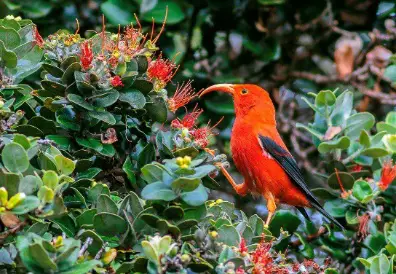
Iwii birds feed on flower nectar, using their long bills to extract the sweet delicacy from a variety of native, as well as non-native plants, such as the Hawaiian lobelioids that have decurved corollas, making these perfectly-suited to feed on.
In fact, according to researchers, the curved bill is suggested to be a possible adaptation for the purpose of taking the nectar from the peculiarly-curved lobelia flowers in bloom.
However,lobelioid availability has decreased dramatically ever since 1902. Because of this, the scarlet honeycreeper shifted to feeding on the nectar from Metrosideros polymorpha trees in bloom (locally known as ʻōhiʻa lehua).
Apart from flower nectar, ʻIʻiwi is also known to eat small-sized arthropods.
The list of other common native plant species used by the Iwii for foraging include Acacia koa (koa), Myoporum sandwicense (naio), Sophora chrysophylla (māmane)), Rubus hawaiensis (‘akala),Myrsine lessertiana (kolea lau nui), Broussaisia arguta (kanawao),Melicope spp. (‘alani),Hibiscus arnottianus (koki‘o ke‘oke‘o),and nonetheless, several lobelias.
In some areas, the nectar derived from the invasive banana poka plant (Passiflora mollissima) is also used as a suitable source of food.
Behavior
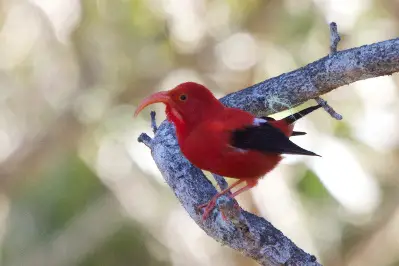
Little is known about the behavior of Iwii birds. Based on the rather limited information available up-to-date, some individuals defend Metrosideros polymorpha (ōhiʻa lehua trees, also referred to as ōhi‘a trees) with plenty of flowers.
‘I‘iwi are also known to make quite long flights, as they travel up to 15 km a day searching for sources of nectar. These birds are typically very mobile; however, their traditional, daily long-distance flights have not been observed lately. What’s more, experts believe that migrations into the mosquito range may be especially harmful to these birds’ well-being and survival in the future.
Unfortunately, with the lack of regular, daily flights in search of flowering māmane and ‘ōhi‘a trees, these amazing birds fail to complete one of their most important roles as part of the ecosystem in their natural range – to pollinate ‘ōhi‘a trees.
Scarlet honeycreepers will give a variety of calls, ranging from gurgling through loud and squeaky. Sometimes, Drepanis coccinea do also mimics the calls of other birds.
During the breeding season, these birds are usually found in pairs. It is after breeding when they may sometimes form flocks consisting of a small number of other Iwii birds.
Reproduction
With I‘iwi, the breeding condition is known to possibly occur in any month.
While females with brood patches can be found throughout the period between December and July, males in breeding condition can be found all year round.
The peak of the breeding condition takes place between February and June and is typically in close association with the peak of ‘ohi‘a plants flowering. It is not before the ohi‘a plants reach a flowering maximum that the Iwii birds will pair off and mate.
Pairs will remain together during the breeding season. Also, the pairs will defend a small territory spanning around the nest. Usually, after breeding, the pairs will disperse.
Due to the interspecific competition for the rather limited, scarce nectar resources, negative correlation in the densities between Zosterops japonicus – aka Japanese White-eye – which has been introduced to the Hawaiian Islands – and the Iwii birds, are observed.
Females lay between two and up to three bluish-colored eggs. The nest, which is built in the terminal branches of a selected ōhi‘a tree, is open cup-shaped and is made from feathers, petals, and tree fibers. The building of the nest is mostly done by the female.
It takes fourteen days for the eggs to hatch, and it is also the female’s responsibility to incubate the eggs, as well as to brood the young. In the meantime, the males are in charge of provisioning the females and feeding the young.
Iwii chicks are yellowish-green in color and are further marked with hues of brownish-orange. In 24 days after hatching, the chicks fledge. It is soon afterward that the chicks attain the typical adult plumage.
Juveniles remain dependent on their parents for less than 120 days. While still dependent on their parents, the young will incessantly follow and call them.
‘I‘iwi birds are known to renest in the case of possible failure. Not the least, some pairs may raise more than just one single brood annually.
Health Risks & Survival Threats
Scarlet honeycreepers are altitudinal migrants. This means that the birds will follow the flowers’ progress as the blossoms continuously develop throughout the year at increasing altitudes.
The search for food at lower elevations exposes the Iwii to disease organisms thriving at these low elevations, and hence, this leads to high mortality rates among the birds. According to one theory, the Iwii is suggested to possibly migrate between islands, and this is believed to be a logical explanation on why the bird has still not gone extinct on some of the smaller islands, like Molokaʻi.
The major disease that leads to high mortality includes the spread of pox and avian malaria among scarlet honeycreepers. Both pose serious threats to the health and future well-being of the Iwii. But what’s more, since the Iwii is the main pollinator of lobelia plants, if the endemic honeycreeper goes extinct, the same unfortunate destiny can happen to the incredible lobelia plant.
It is some of the non-native, tropical mosquitoes that have been recently introduced to the islands by humans, to carry avian diseases, and in particular, avian malaria. On the bright side, these mosquitoes cannot live at high elevations, so viable populations persist solely at elevations above 1500 meters since, at such elevations, the disease-carrying mosquitoes are very rare, if not entirely absent.However, this is not really good news, since the natural range of these bird species has forcefully contracted to higher elevations only during the past decade or so, because of the threat posed by mosquitoes.
A single bite from a mosquito that has been infected with Plasmodium relictum has been found to lead to 90% mortality, with 9 out of 10 juvenile scarlet honeycreepers falling victim to the nasty disease. Also, when bitten more than once, 100% of the Iwii birds died of malaria.
One single Iwii was reported to have successfully developed immunity after being bitten by the malaria mosquitoes. The same bird managed to survive further challenges after multiple mosquito bites, yet there is no evidence on whether or now the Iwii populations are capable of developing resistance to the disease, and whether or not a similar disease resistance may occur with other Hawaiian species alike.
Conservation
The primary threats to scarlet honeycreepers include disease, and in particular, avian poxvirus and avian malaria, and both of these are transmitted to the birds by Culex quinquefasciatus, a non-native southern house mosquito. As of now, part of the birds have retreated to areas in the mountains at high elevation, where the temperatures are cooler, and the mosquitoes fail to thrive, however, as the climate crisis persists and temperatures continue to rise, the iwii populations remain extremely vulnerable, and especially since these birds demonstrate high mortality due to avian malaria.
Habitat loss and degradation, non-native ungulates, invasive non-native plants, and nonetheless, non-native predators, and climate change, are all factors that put the iwii at high risk of extinction. Therefore, conservation efforts must be accelerated, especially since the existing 5-years conservation plan from 2013 to 2017 has not to lead to stabilizing the populations of iwiis.
After being uplisted to receiving “Vulnerable” status in 2008, it was on the 20th of October 2017 when the iwii was listed as Threatened with extinction by the USDI, yet the population trend is decreasing as of 2019, and no Action Recovery Plan is currently running.
Availability – Where to Get an Iwii?
You cannot get an Iwii in the same sense as you can get a European goldfinch, among other birds that can be legally kept as pets.
The scarlet honeycreeper is a native bird species that only thrives on the Islands of Hawaii, and it is also endangered with extinction. Therefore, these birds cannot be purchased, traded, or otherwise taken care of by the average bird care enthusiast. Instead, only licensed wildlife rescuers can get to care for the Iwii birds.
If you ever come across anybody offering you a scarlet honeycreeper for sale, immediately contact a conservation officer!
Fortunately, Iwii birds can be admired freely in the wild. Those who wish to see these impressive living creatures can plan a vacation to some of the Hawaiian Islands where these animals can be still seen.
Patience is crucial, though, as it may take hours, if not days, before one is able to notice a scarlet honeycreeper among the vegetation in its native range, above 1500 meters of elevation in the mountain forests of the big Island in Hawaii. One can also choose to visit the Hakalau Forest National Wildlife Refuge, where these amazing feathery living beings are more in number than in other places across the Hawaiian Islands.
Interesting Facts
1. Being a highly recognized symbol of Hawaii, the ʻIʻiwi is often mentioned in Hawaiian folklore, e.g., in the Hawaiian song “Sweet Lei Mamo.”
2. The scarlet honeycreeper is the third most common native bird that is known to inhabit the Hawaiian Islands.
3. The peculiar song of Drepanis coccinea is described as a combination that consists of the squeaking of a rusty hinge, the sounds of balls dropping in water, the sound of balloons rubbing together, and a couple of cheerful whistles.
4. The iiwi is a part of a large group of birds endemic to the Hawaiian Islands, which number about 50 in total. All of these endemic birds have actually descended from a single common ancestor, namely the Eurasian rosefinch.
According to studies, the Eurasian rose finches somehow managed to arrive in Hawaii all the way back into 5 million years ago, and ever since, they have further managed to evolve into 50 new species. Each of these species exploits and benefits slightly different ecological niches by inhabiting particular regions of the islands with varied climate and vegetation.
5. A single of the ancient cloaks of the Hawaiian nobility, made up by using the Iwii’s feathers, could have up to 250 000 feathers. Back in the time when the Iwii birds were still plentiful, the Polynesians also created impressive feathered capes, with a single cape possibly being made up by the inclusion of up to 100 000 feathers, being considered a status symbol reserved exclusively for the local nobility.
6. It is often the case that iwiis will move about their habitat in small groups, consisting of about a dozen or more. But what’s more, these birds do also defend themselves as a group, too! If one of the group members is to detect a possible threat, the bird is to then communicate it to the rest of the birds with a call, until the entire group goes silent, and in the best-case scenario, managing to escape from the threat by staying below the radar.
7. The word ʻIʻiwi is derived by Hawaiian language linguists. The word has a Proto-Nuclear-Polynesian origin, and is actually “kiwi.” In central Polynesia, the word “kiwi” is used to refer to a migratory bird, namely Numenius tahitiensis (a medium-sized shorebird, aka the bristle-thighed curlew), as the de-curved, long bill of the bristle-thighed curlew somewhat resembles the bill of the iwii.
How to Care for the Iwii
Currently, Drepanis coccinea is listed by The International Union for Conservation of Nature’s Red List of Threatened Species as “Vulnerable.” What this means is that the future of this bird species is entirely dependent on the actions or lack of actions of humans.
There have been a total of three major actions lead by humans, to have lead and to continue leading towards the decline of the iwii bird, until it possibly reaches the phase of becoming extinct.
The first is the introduction of the non-native species, such as the avian malaria-spreading mosquitoes, as well as mongoose, to the islands all the way back in 1888. Mongoose was introduced in an attempt to kill invasive rats. However, mongoose slaughtered native birds by eagerly consuming their eggs and chicks.
The second major offense is none other but the deforestation of the Hawaiian forests, then again, triggered by humans, mainly for modern-day housing and urban areas. And since the iwii is a crucial pollinator, relying heavily on the nectar of Hawaiian lobelioids, while humans make room for their own expansion, the scarlet honeycreeper’s most important food source simply keeps disappearing.
Thirdly, and by far, the most devastating effect that has caused and keeps causing the negative population trend among iwii populations is the acceleration of climate change. What’s more, as the temperatures keep rising, the mosquitoes carrying avian malaria, which is deadly for the iwii, keep making their way further up into the mountains of Hawaii, and at some point, the mosquitoes will inevitably reach what is considered the final stronghold of the scarlet honeycreepers – the high mountains of the Big Island in Hawaii.
To take care of the iwii means to take care of ourselves, and in particular, to take care of restoring the ancient, deep relationship we share with Mother Nature. By understanding that the future of this bird species, among many other animal species, lies in our hands, we have the collective power and responsibility to spread awareness, to embrace environmental-friendly ways of living, and ultimately, putting a stop to climate change.
It is fully possible to donate some of your free time and/or money for wildlife conservation.
FAQ Section
Where Does the Iwii Bird Live?
Nowadays, more than 90% of the population of Iwiii birds that remain in the wild live in clusters in Hawaii’s big island, and in particular, the mountain forests located at elevations above 1500 meters. Back in time, the populations of Iwii birds used to be ubiquitous on all of Hawaii’s major islands.
What Does the Iwii Bird Eat?
The Iwii bird feeds predominantly on nectar, using its specialized, down a curved, long bill to extract and sip nectar from different tubular flowers. Although these birds mainly eat nectar, they are also known to take small arthropods, too.
How Many Native Birds Are in Hawaii apart from the Iwii?
There are 71 existing taxa of birds that are endemic to Hawaii and the Hawaiian Islands. Nearly 50% of these birds have already gone extinct, 6 are considered possibly extinct, while 30 are threatened with extinction up-to-date, including the Iwii.
Is the Iwii Endangered?
Yes, the Iwii is endangered with extinction. As of September 19, 2017, the scarlet honeycreeper has been officially listed as Threatened species, and is under the protection of the law, based on the Endangered Species Act.

